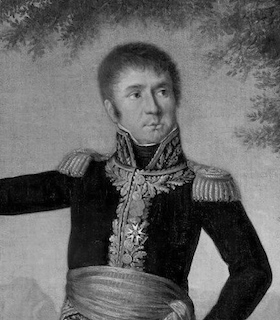General Thomas Mignot de Lamartinière

Born: February 26, 1768
Place of Birth: Machecoul, Loire-Atlantique, France
Died: September 6, 1813
Cause of Death: Mortally wounded
Place of Death: Bayonne, France
Arc de Triomphe: LAMARTINIÈRE on the west pillar
Pronunciation:
The son of a master surgeon, Thomas Mignot de Larmartinière was commissioned as a sous-lieutenant in the 2nd Battalion of the 32nd Infantry Regiment in September of 1791. He was sent to the Army of the Rhine where in May of 1792 he was promoted to lieutenant and in September he was promoted to capitaine. In 1793 Larmartinière served at the Siege of Mainz and in July he was wounded by a shot ot the left thigh during the attack on the redoubts. After the surrender of Mainz, he and his fellow soldiers were sent to the Army of the West and the Army of the Coasts of the Ocean. Larmartinière distinguished himself at the Battle of Quiberon at Fort Penthièvre in July of 1795. A year later he became an aide-de-camp to General Valletaux and he was promoted to chef de bataillon. Larmartinière was designated for the second expedition to Ireland and in August of 1798 he embarked on the frigate Immortalité. On October 20th he was wounded and taken prisoner by the British. Exchanged and released in March of 1799, Larmartinière then joined the Army of the West. In December of 1800 he was promoted to chef de brigade of the 77th of the Line.
During the peace that followed Larmartinière served in garrison at Saint-Brieuc and then Bordeaux and in 1803 he was at the camp of Bayonne. That October he was named colonel of the 50th of the Line in the Army of Holland and he went on to serve at the camp of Montreuil. When the Grande Armée marched out in August of 1805 to confront the Third Coalition, Larmartinière and his men served in the 3rd Division of Marshal Ney's VI Corps. On the campaign that fall, he distinguished himself before Ulm and after the conclusion of the campaign he was named a Commander of the Legion of Honor. After serving in the campaigning of 1806, Larmartinière took an active part in the Battle of Eylau in 1807 and afterwards he was promoted to général de brigade. He took command of the 2nd Brigade of the 3rd Division of IV Corps.
In 1808 Larmartinière was named a Baron of the Empire and he was sent to the Army of the Spain to serve on the staff. In February of 1809 he was named commander of Tuy and then in April the insurgents of Galicia laid siege to Tuy. General Heudelet marched to Larmartinière's rescue and defeated the insurgents. In November of 1809 Larmartinière took command of a brigade in Reynier's division. Next in February of 1810 he took command of a brigade formed by himself at Burgos and he was sent to Madrid. Larmartinière commanded a brigade at Avila under Kellermann in June of that year and in October he joined the Army of the Center. For much of 1811 he served as interim commander of the 11th military division at Bayonne and then in September he was named chief of staff of the Army of Portugal, serving under Marshal Marmont. In July of 1812 Larmartinière served at the Battle of Salamanca and then in February of 1813 he was promoted to général de division. He took command of a division and served under General Reille, fighting at the Battle of Vitoria in June of 1813. The next month Larmartinière served at the combats of Cubiry and then in August he fought at the combat of Irun. On August 31st Larmartinière was serving during the attack on the bridge over the Bidasoa at Bera (also known as Vera) when he was wounded by a British sniper. He was taken to Bayonne where he died of his wounds.
Bibliography
- Divry, Arnauld. Les Noms Gravés sur l'Arc de Triomphe. Paris: L'Harmattan, 2017.
- Six, Georges. Dictionnaire Biographique des Généraux & Amiraux Français de la Révolution et de l'Empire (1792-1814). 2 vols. Paris: Gaston Saffroy, 2003.
Updated April 2018
© Nathan D. Jensen